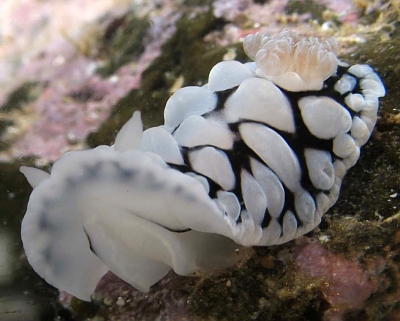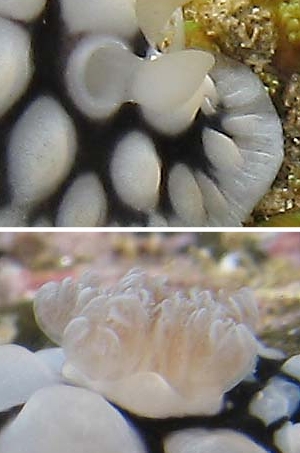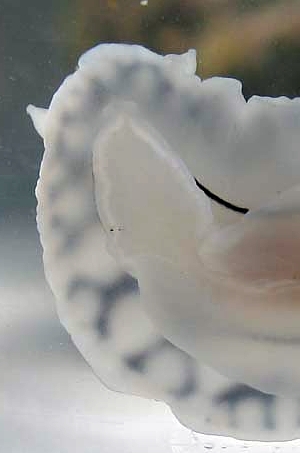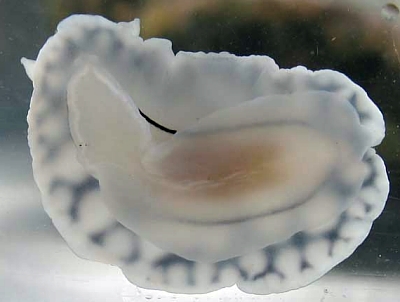Re: Phyllidia mimic from Indonesia
June 20, 2007
From: Philibert Bidgrain

Concerning message #19370:
Dear Bill,
Reunion Island seaslug
For the discussion about this unidentified species, I send you three photos where we can see some detail of another specimen of this species found in our Island
Some remarks about our specimen:
The large five (or six?) compound gills which form a circle around the anus emerge from a deeply lobed branchial pocket. The mantle is soft, and a black line runs between the foot and the mantle.
Locality: Etang sale, less 1 m, Reunion Island, Indian Ocean, 13 December 2006, Rocky coast. Length: 20 mm. Photographer: Philibert Bidgrain.
We have observed Dendrodoris carbunculosa on our island, but the pattern is really different [see on our website]. I think that it will be another species ... I'm interested in any information about this species...
Best regards
Philibert Bidgrain
http://vieoceane.free.fr/runseaslug/indexslug.htm
pbidgrain@yahoo.fr



Dear Philibert,
Your photos only go to show how useful a photo of the underside of the animal is. From the shape of head - almost non-existent - I am now sure this is a species of Dendrodoris, and your upper photo shows the mantle is more rigid than I thought from Ken Tucker's photo. Also the lobes around the gill pocket are usual for dendrodorids such as D. carbunculosa. Also in the middle left photo I have a close-up of the rhinophore which shows it has the characteristic shape of these big warty dendrodorids. The only feature which doesn't seem to fit adult D. carbunculosa is the black line around the inside edge of the underside of the mantle. Perhaps this dark line turns into the very dark brown - black band present in many large specimens.
Your animal is indeed a Dendrodoris, and I now agree with Cory Pittman [#20045 ] and Erwin Koehler [#20047] who both suggested earlier today that Ken's animal might be a juvenile D. carbunculosa.
Best wishes,
Bill Rudman
Related messages
-
Dendrodoris carbunculosa from French Polynesia
From: Peter Brink, April 9, 2010 -
Phyllidia mimic from sthn Queensland
From: Gary Cobb, March 4, 2009 -
Re: Phyllidia mimic from Indonesia
From: Erwin Koehler, June 19, 2007 -
Re: Phyllidia mimic from Indonesia
From: Cory Pittman, June 19, 2007 -
Phyllidia mimic from Indonesia
From: Ken Tucker, June 18, 2007 -
Dendrodoris carbunculosa detail from N. Sulawesi
From: Linda Ianniello, November 26, 2005 -
ID of the biggest nudibranch I ever found!
From: Emmanuel Tardy, November 3, 2005 -
Re: Dendrodoris carbunculosa with commensal shrimps
From: Barbara Hanchard, August 10, 2005 -
Dendrodoris carbunculosa with commensal shrimps
From: Barbara Hanchard, August 5, 2005 -
Dendrodoris carbunculosa from Anilao, The Philippines
From: Paul Osmond, May 17, 2005 -
Dendrodoris carbunculosa from Reunion Island
From: Philibert Bidgrain, February 23, 2005 -
Dendrodoris carbunculosa or what?
From: Tina Owens, December 6, 2003 -
Dendrodoris carbunculosa from Hawaii
From: Matthew Cummings, August 28, 2003 -
Dendrodoris carbunculosa Nudi From Batam
From: Alice Lee, July 7, 2003 -
Dendrodoris carbunculosa from Kona , Hawaii
From: Richard Lundholm, June 6, 2003 -
Dendrodoris carbunculosa from Indonesia
From: Takako Uno, March 15, 2003 -
Dendrodoris from South Africa
From: Linda Penny, September 10, 2002 -
Dendrodoris carbunculosa? from the Seychelles
From: Erwin Koehler, June 16, 2001 -
Dendrodoris carbunculosa from East Pacific
From: Clinton Bauder, September 1, 2000 -
Dendrodoris carbunculosa from Sulawesi
From: Lindsay Warren, April 1, 2000 -
A larger Dendrodoris carbunculosa
From: Clay Carlson & Patty Jo Hoff , December 8, 1999 -
re: Dendrodoris carbunculosa
From: Yoshi Hirano, December 1, 1999 -
Is this the largest nudibranch?
From: Yoshi Hirano, November 30, 1999 -
Dendrodoris tuberculosa & D. carbunculosa
From: Bill Rudman, November 30, 1999 -
Dendrodoris carbunculosa from Philippines
From: Erwin Koehler, December 20, 1998
